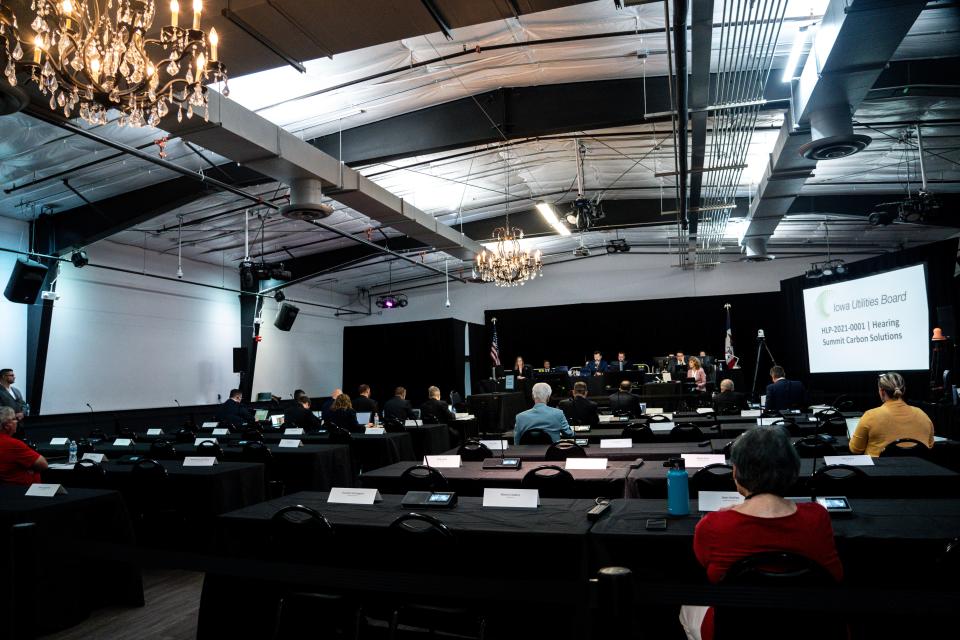Iowa should keep utilities from charging customers for things they don't need
Alliant Energy electricity rates feel like a runaway train to Iowa ratepayers, and over 70 Alliant-served towns have passed resolutions asking the Iowa Utilities Board to get serious about the situation.
There is growing evidence that MidAmerican Energy’s very healthy profits from the export of Iowa wind power are taking precedence over needed investment in energy storage and grid reliability.
Are Iowa’s large investor-owned electricity providers too big to regulate with existing tools? Are they prioritizing the interests of largely out-of-state shareholders over the interests of Iowa customers and communities?
ANOTHER VIEW: Transparent energy planning is already occurring, the Iowa way
Utility regulators need a robust toolbox
Legislators need to ensure regulators have the tools they need to ensure that Iowa ratepayers only pay for what they need.
The most important tool lacking from the Iowa Utilities Board’s toolbox, according to a major new report commissioned by the Legislature and produced by London Economics International, is Integrated Resource Planning, or IRP.
The report “recommends that the Legislature enact a statute mandating rate-regulated electric utilities periodically submit IRPs to the IUB for review and evaluation.”
The report goes on to state that the “absence of compulsory filing of long-term resource plans impedes the IUB’s access to vital information essential for informed decision-making. … Such a process could provide greater insight into the current status and future needs of the system — in addition to addressing the policy objectives of adequate and reliable service and just and reasonable rates.”

IRP basics: Pay for only what you need
While utility regulation can be complicated, the concept of Integrated Resource Planning is fairly straightforward. Here are the basics on how IRP can help keep rates down, and reliability up, in Iowa.
Energy utilities are state-granted monopolies not subject to competitive markets. This is makes sense as nobody wants multiple sets of electric or gas lines, but monopolies also carry high moral hazard, and so require a robust and transparent regulatory process for regulating rates.
The profits of investor-owned utilities like Alliant and MidAmerican are based on the capital assets they own and the regulator-approved rate of return, not on how efficiently they manage the electric grid.
This approach creates a perverse incentive for investor-owned utilities: the more they spend on capital assets, the more they earn and ratepayers pay, whether the assets are truly needed or not.
This is why, according to the London Economics report, almost all states that regulate electricity like Iowa utilize IRP as a pre-cursor to traditional rate dockets: IRP is the comprehensive, transparent, participatory, and regularly recurring planning process that defines the key resource needs in the short, medium and long term, and the most economical pathways to get there.
With IRP in the toolbox, the Iowa Utilities Board would be in a better position to ensure the mid- and long-term needs of the grid are being met, and ratepayers are paying for only what they truly need. Competitive procurement is a critical complement to the IRP process to keep costs down.
Alliant and MidAmerican's rate histories
Two very different IRP-related bills have cleared the first funnel at the Iowa Legislature.
House File 2554 makes IRP an optional process that may be ordered by the Iowa Utilities Board prior to approving “advanced ratemaking principles” for new renewable energy projects. But if the goal of IRP is for ratepayers to only pay for what they need, it must be a mandatory, comprehensive process on a regular cycle, as it is in virtually all states, and as Senate File 2244 proposes.
The rapidly rising rates experienced by Alliant customers demonstrate this point. Between 2021 and 2025, the company plans to spend $960 million in distribution system investments. These investments are a major driver of recent and proposed rate hikes, and should all have been subject to the strict scrutiny of a robust IRP together with, but not dependent upon, the company’s renewable energy plans.
The state’s other investor-owned utility, MidAmerican Energy, hasn’t brought a rate case to the Utilities Board since 2013. This leaves regulators no window into why MidAmerican customer bills are steadily rising, and especially, whether customers may be facing “rate shock” in coming years. A recent case also called into question whether large wind investments are needed by ratepayers, or are simply profit engines for company shareholders.
The utilities will surely object loudly to the establishment of a comprehensive, mandatory, participatory IRP process in Iowa as unnecessary and costly regulation. What they’re really worried about is a policy that may reduce profits to monopoly investors by keeping more energy dollars with customers and communities across the state where they belong.
As the London Economics report clearly explains, a robust IRP process is the tool most needed by regulators to efficiently and effectively ensure that Iowa ratepayers only pay for what they need.

Andy Johnson is executive director of the Clean Energy Districts of Iowa, which serves 12 Iowa county-level Clean Energy Districts covering roughly a third of Iowa’s population. The districts support local ownership of and prosperity from the clean energy transition.
This article originally appeared on Des Moines Register: Iowa should pass law so utility customers pay for only what they need

